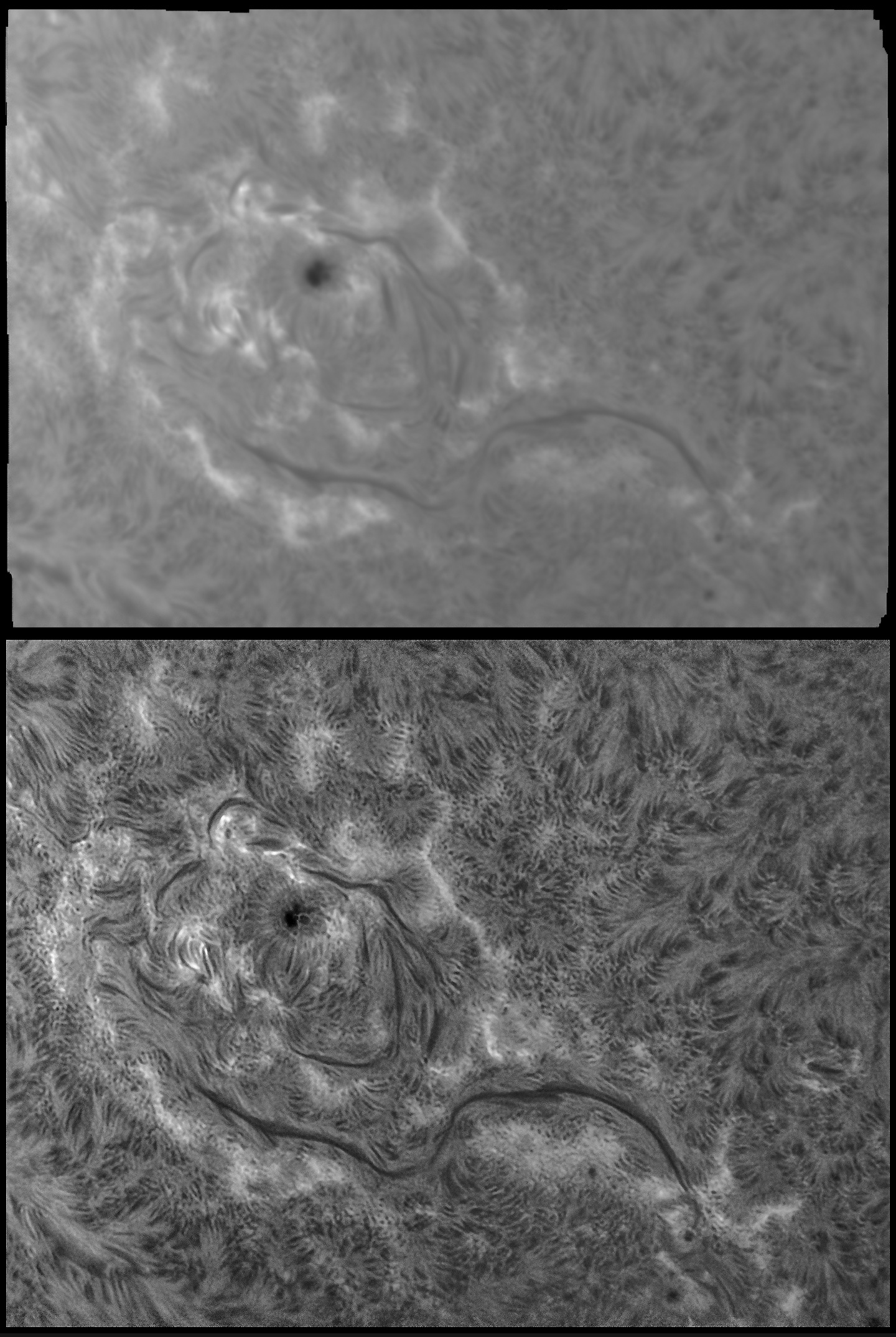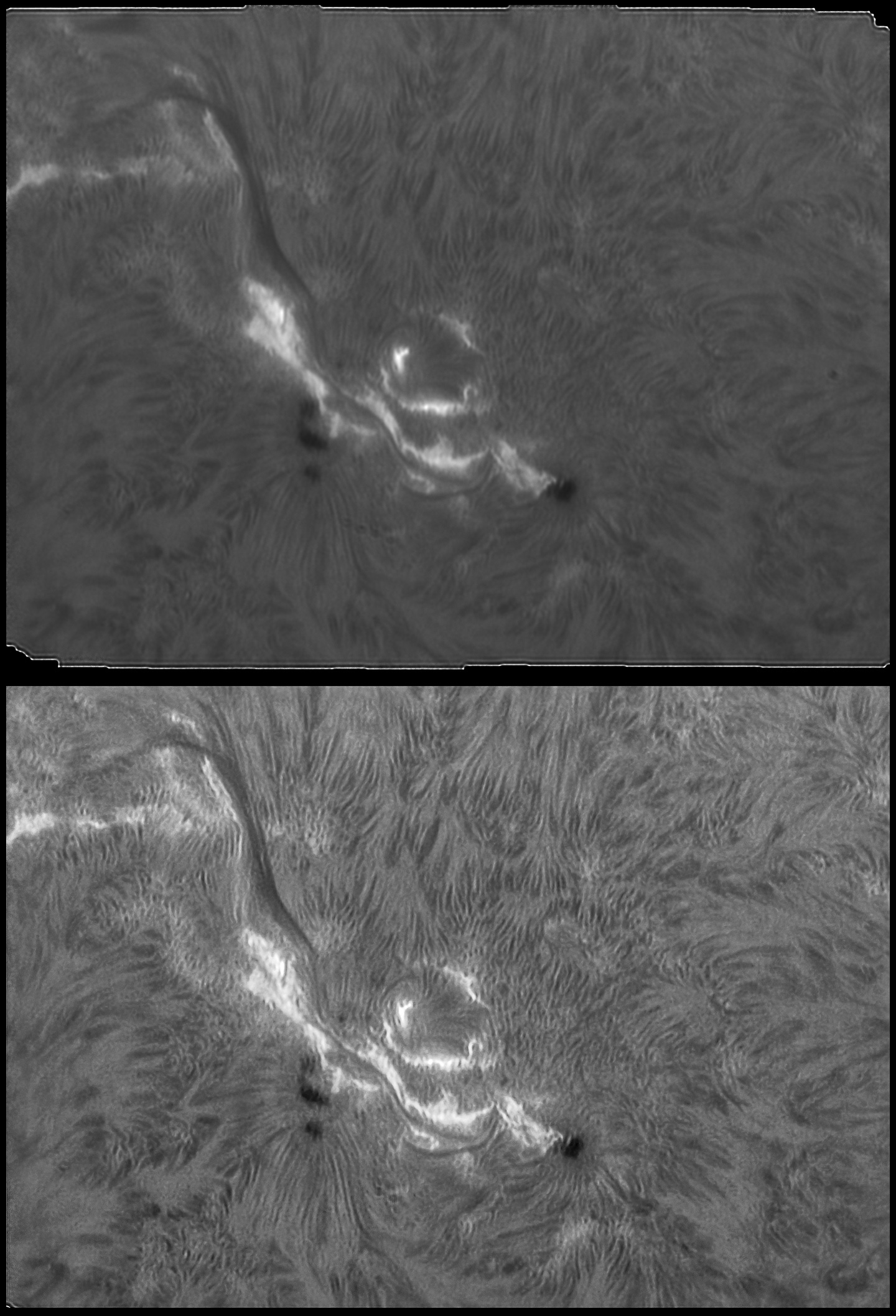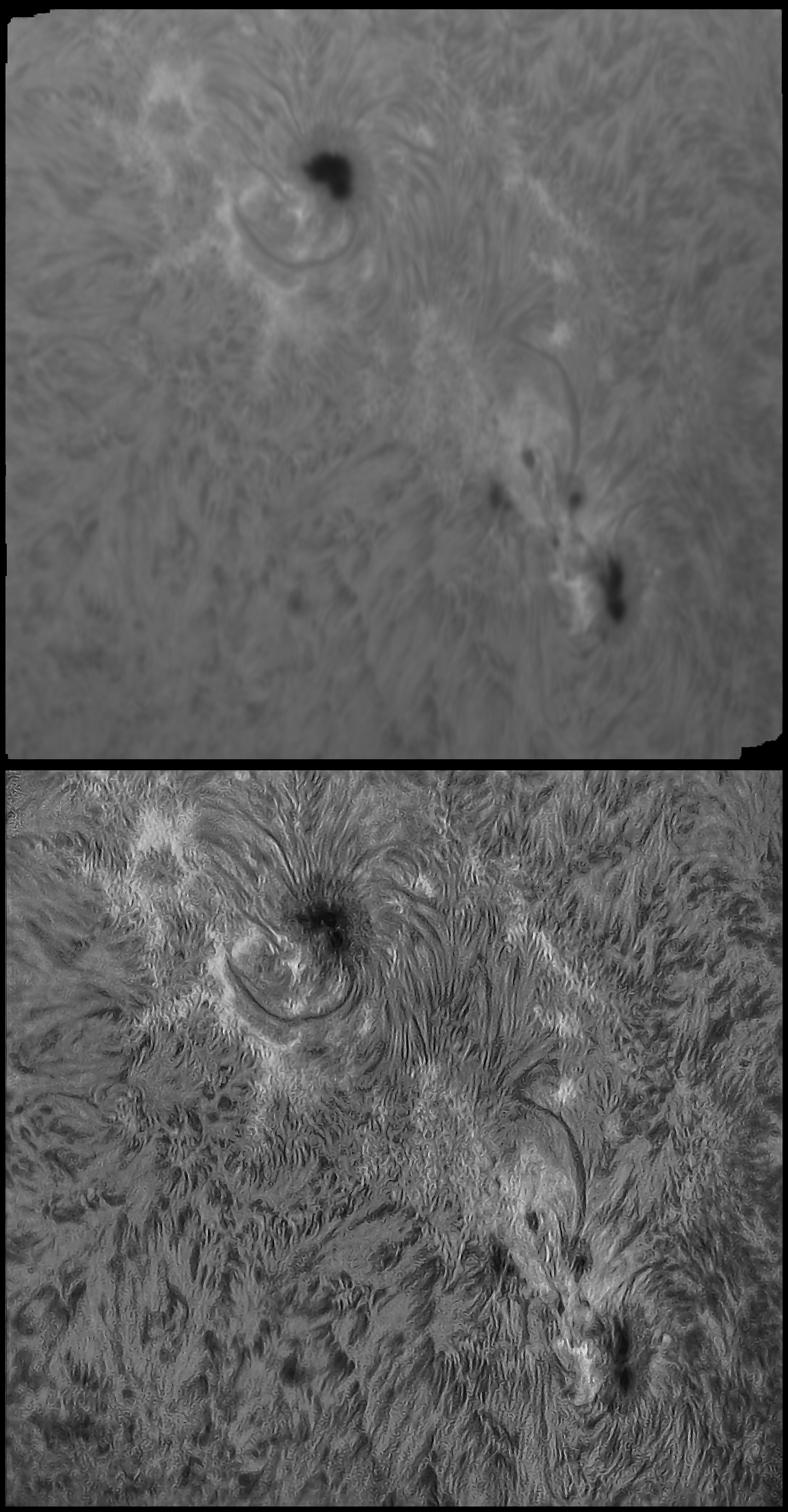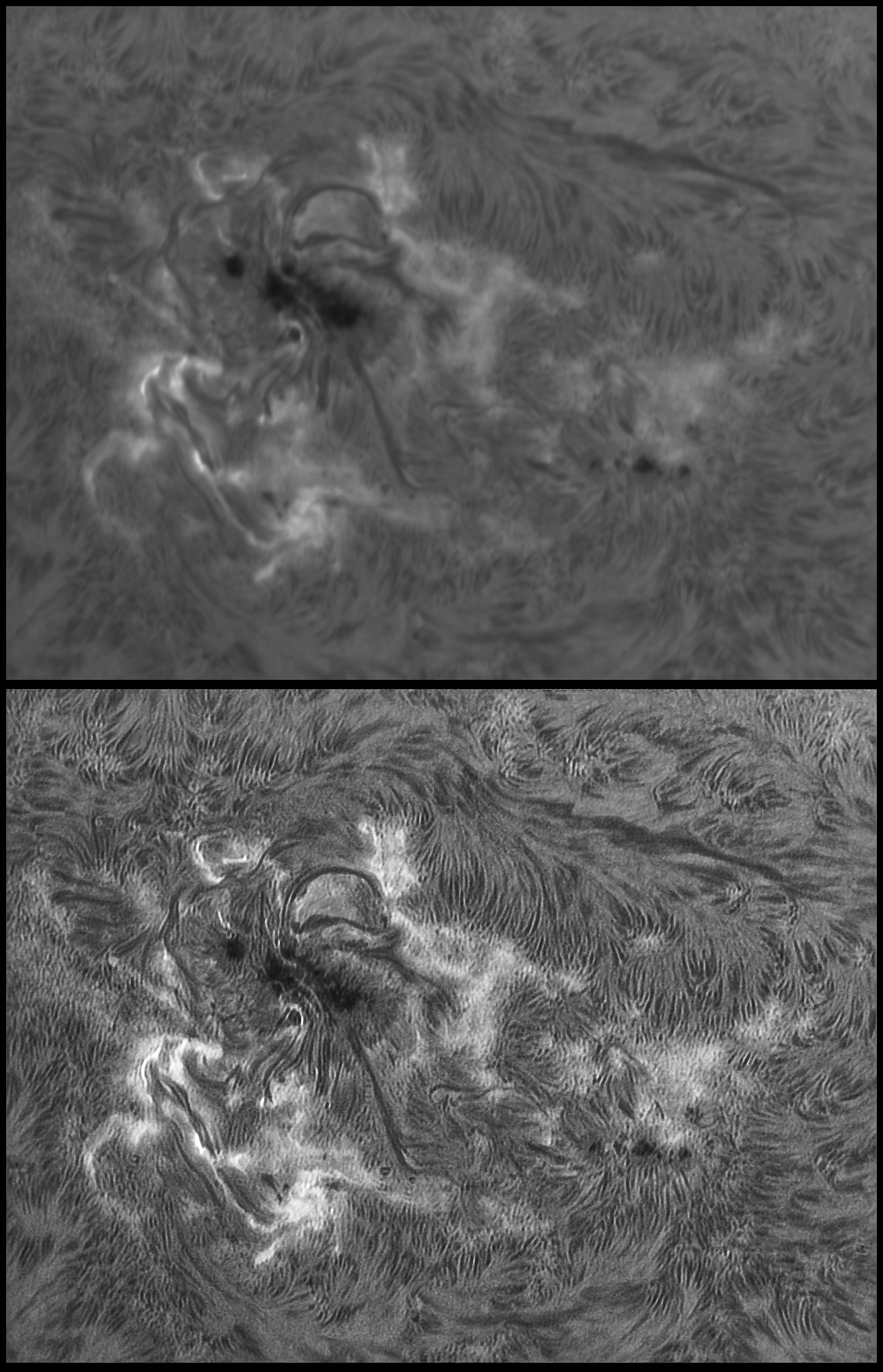Small Moves
9/12/2024. When I use my well-practiced but, alas, still inadequate processing regime on solar images, the thread-fine filaments I know are there tend to "rope out," to begin to resemble ropes, snakes, and garden hoses rather than the spider silk some of them are. Let's fix that.
"Small moves, Ellie. Small moves," says David Morse to Jodie Foster in "Contact." The advice (which is offered twice, once about tuning a radio and again about joining an interstellar chamber of commerce) is good for teasing signal from noise in narrow-band solar images, too. What I want is a one- two- or three-step process to convert freshly stacked data into finished images, and sometimes I imagine I have one. But what actually works is an incremental workflow comprised of many small steps.
Here's an example -- I think a promising one -- using data taken on 9/08. The raw stack is the output from AutoStakkart!4 using the best 400 of 4,000 frames. The finished image is the end result (for now) of a long, patient workflow. It's still a little noisy and a bit "harsh" but it's getting there:

Of course you can click it!
Depending on how you count them, there are 20 (or so) identifiable steps between the raw image up top and the finished image down below. Rarely can I see the difference from one step to the next, so you have to know why each step matters rather than just stumbling along one after another. Taken all together, the process works, but the steps have to be part of a plan, and the plan has to be executed one small step at a time.
Here's another example. This is a flare near its peak on 8/24. I've got a lot of fodder to work with while figuring this out (and a lot of potentially good images if I do).

The broad strokes for both these examples look like this:
- Crop borders. They corrupt histogram-based analyses and processing near their sharp edges introduces artefacts into the image.
- Use ImPPG's L-R deconvolution to bring up fine detail. Use the histogram adjustments and unsharp masking tools, too. Use all ImPPG's options carefully and with as light a touch as possible while still producing a visible benefit. With a 2800 pixel image from the 92mm refractor, 50 iterations of L-R with a setting of 4.5 - 5 is about right. Use higher settings for larger images stacked with Drizzle 3 in AS!4. As for USM settings, lower the threshold to ~0.8 and use a low sigma (~1.2). It's really easy to over-process in ImPPG (compare, "You can do a lot of damage with powerful tools"). Keep in mind that you are not trying to produce a finished image right here and now, so don't be tempted. You're just tee-ing up detail to bring out later in the workflow.
- If there is a strong gradient in the photo (owing to a poor flatfield or proximity of the solar limb or whatever), this is the point at which to address it. There are several tools available and more than one simple technique. Pick one: GradXpert or Automatic DBE in PixInsight (PI offers others), AstroFlat or GradientXterminator in Photoshop. Any of those can be (often is) too aggressive with solar work. Try my usual favorite: make a duplicate layer, invert it, then blend with the original in softlight mode while adjusting the histogram of the inverted layer. This may cost some dynamic range within important details, so, in keeping with today's theme, make small moves. Do not overdo. Flatten and proceed.
- This might be a good time to apply a gentle (2-3 out of 10) noise reduction pass in Photoshop. After this, we're working on pulling up fine structure and noise is not something we want to emphasize.
- Rather than overwork sharpening routines in PI, ImPPG or PhotoShop, make a duplicate layer in PS, and combine with blend mode "multiply." Unless you raise the black point of both layers and lower their white points to give the combination some room to work, the result will be very dark. You're trying to darken the core of fine filamentary detail imaged near the diffraction limit more than you darken the shoulders of the detail. It's all too easy to darken the entire PSF and lose fine structure.
- The Camera Raw Filter is your friend here: keep the highlights and shadows away from their limits.
- Now's a good time to try BlurXterminator in PixInsight. Under nonstellar options, try 2.8 or so for the Point Spread Function and 0.4 for sharpening. Oversampled images (as with drizzle 3) or images made without a reducer in the optical path may benefit from larger PSF values. This can be a little slow, but experiment anyway. Get some coffee and pursue small improvements.
- Use PI's histogram process (try curves, too) to preserve highlights and shadows. Revisit Camera Raw in Photoshop, try Photoshop's sharpen routine (the simple one), also "sharpen edges" but be alert for small-scale flaws and back off if you see any. It's sometimes worth applying "sharpen edges" moer than once; sometimes not. Be cautious.
- Somewhere around here, as you can see, the workflow has devolved into try-it-and-see-what-happens mode.
- An unaggressive unsharp mask step may help, but take it easy lest you begin "roping out" the fine details we've been trying to keep.
- Overlaying a high-pass layer may contain and even reduce the expansion of fine detail into "ropes" which is a consequence of increasing contrast (which is a lot of what all this is about). An "emboss" layer. In either case, reduce noise in the new layer and try off-setting it by a few pixels; try blend modes overlay, softlight, hardlight, vividlight to see which works best for the image in hand, always watching out for the creation of small-scale defects.
- And finally a very light noise-reduction pass on the (supposedly) finished image may help smooth any over-exuberance or accentuated noise.
Or something like that.
I tried to pretty much follow that ordered list as a recipe, with occasional divergences to seize opportunities and avoid obvious mistakes. The result was this from 08/24:

I think we're onto something. Another, from August 10:

I've used enough of your bandwidth on this. More examples and notes on the next page if you want 'em.
:: top ::